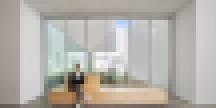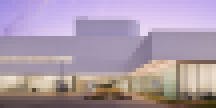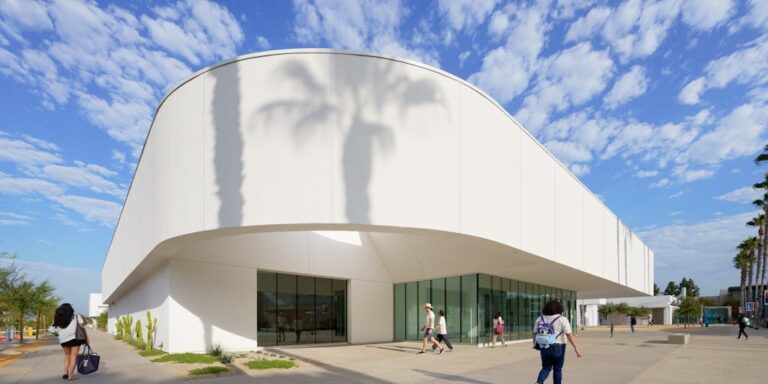When the designers came up with plans to revitalize California State University’s visual arts facility in Fullerton, they wanted to create spaces that encourage students to stay on campus as much as possible.
Many Fullerton students commute to campus from their homes. This means you need a comfortable place to do your homework, meet your professor, and talk to your classmates. If not, they risk going back home and skipping classes or losing academic help.
The new Visual Arts Complex, which costs around $65 million for the university, includes two new buildings and two other renovated spaces. Apart from creating modern facilities that allow students to focus on careers in animation, game art, or graphic design, designers have thought up the basic necessities of university students: access to WiFi. Where to set up your computer. Suitable shades from the California sun. Even a comfortable seating.
Ideally, if students feel safe on campus throughout the day, they would also want to be in Fullerton for the long term, says Christina Delgado, project manager for Fullerton’s Visual Arts Complex.
They have placed a new emphasis on campus design, especially as enrollment numbers continue to decline as universities look for ways to engage and retain students, says Delgado, who is also the leader of the HGA Arts, Community and Educational Practice Group, who led Fullerton’s latest construction project.
Both university and K-12 schools, the building aims to prepare students for the next stage of their lives, Delgado says. For younger students, it could be the next grade level or school, she says. The K-12 building should have a variety of spaces, such as music rooms and science labs, so that students can explore their interests and be excited about the university.
Instead of simply providing classroom space, higher education institutions are thinking about how students prepare themselves to take the next step in their careers. As a result, experts say, they need to start off campus, work with peers, and design flexible spaces that grow both in the student population and in the programs offered by the university.
“You need to be able to create space… you want people to be involved,” says Delgado. “It’s not just about learning skills and leaving. It’s about having life experiences.”
Adapt to the new generation
Delgado sees Fullerton’s new visual arts complex as a “micro-campus,” or a collection of buildings where everyone has a similar focus. The designers have tried to make use of the entrance or wider corridor to provide more space for students to take breaks between classes, she says.
The designers also took advantage of Fullerton’s warm climate. For example, one of the final touches of a project is outdoor furniture.
“Students will have a place both inside and outside just to be on campus,” says Holland. “They shouldn’t feel like they have to leave campus whenever they go to the car or when their next class starts now.”
The campus is also focusing on creating more space for collaboration, experts say. Visual Arts Complex is not necessarily for class hours, but has a new computing lab that allows students to work together, Holland says.
The space helps students feel more comfortable working and approaching with professors, Delgado says. In recent years, faculty members have noticed that students have come to university with anxiety and shyness. Many people do not attend opening hours because they can’t find a professor’s office or feel threatened.
In one of Fullerton’s new buildings, teacher offices are being built around a large communal space. This means that all the offices are in one central location, making them easy to find. And it gives students the option to meet with their professors outside the office, which can be nerve-wracking, says Delgado.
“A lot, a lot, over the years, we’ve put teachers here and there,” says Holland. “It will only take a few minutes for students to run to the building of E. after they have a meeting with the faculty on the construction of A.”
Now everyone is in the same place. “The suites are next to each other,” he says. “And there are these areas where students are justified. [hang out] When they are about to go from Teacher A to Teacher B. ”

Lalit Agarwal, president and CEO of APPA, an organization that supports staff at educational facilities, said universities across the country are making spaces more collaborative, such as libraries and science labs.
In the past, university libraries have been “book shelves in every corner and books shelves where people can bow their heads and accomplish their homework.”
Today, he says, many of these books are moved or digitized. Libraries are becoming more open and supportive. The furniture will be relocated and students will be able to cooperate comfortably, he says.
Career preparation
The university uses physical space to push students towards the next step in their careers.
In Fullerton, the building was designed as a “blank canvas,” says Delgado. The walls remain primarily empty, so student art serves as decoration, with the first floor having a large window where people can see the artwork from outside.

The complex includes two student galleries and a public gallery, allowing students to gain experience displaying their work for a general audience. Students and faculty can also use designated “criticism spaces” to evaluate student projects, Delgado says.
The world of visual arts is not particularly accessible. The design of the campus should help students feel more comfortable working in the field before they graduate.
“You want to come and learn, but in order to keep them on campus, you have to show them, ‘Oh, I can make it, I have the tools to make it,” says Delgado.
The university embraces the need for students to get out of the classroom, says Radal Winling, a history professor at Virginia Tech and author of Ivory Towers in the 20th century that came out in 2017.
But this means the campus is bigger and spread across the surrounding communities and neighbourhoods, Winling adds. While communities and universities often rely on each other, the spread of campus can cause tensions between local residents and administrators, which can lead to faculty and students getting caught up in the middle.
“These types of community negotiations are extremely difficult,” Winling says. They are politically sensitive as faculty may be evacuated or seeking to develop relationships with the institutions they are trying to evacuate through student projects or expansion of campuses.
If designers can use the building to think beyond students alone and also consider the potential for community use, Delgado says, it could help ease tensions. For example, local high schools recently used Fullerton’s gallery space for their choir performances.
“The sound there is pretty crazy,” she adds. “The choir listens to sing in a large gallery space that is not acoustically designed for musical performances, and the boy is impactful, loud and surprisingly resonating.”
Flexibility is important
Agarwal said the new campus buildings should be flexible even within the university’s expected use. Flexibility allows for more efficient investments and allows students to explore multiple careers.
In the past, students usually took one job from university and remained in that job for the rest of their careers. Now, students want to explore options and be exposed to a wide range of fields, he says. The university needs to provide them with the opportunity to experiment.
Audrey Sorensen of the facility advocacy group APPA says some universities will create spaces that can change throughout the day. And, over the long term, rather than having a building dedicated to a single department or task that only functions at one point in time, universities can build changing spaces in rapidly developing fields, she says.

In Fullerton, many rooms were designed to adapt to the increasing use of technology in the arts, says Holland. For example, if you have additional space for new wiring and the room needs to be used for painting, there is space to install ventilation.
“We don’t know what’s going down the line,” Sorensen says. [colleges] Rather than trying to siloify the space into a dedicated role, it is spent on it. ”
Ultimately, it’s about ensuring that students want to stay in school and stay in school, Delgado adds. When new students arrive at university after high school, classrooms on new campus should help them get excited about finding work ready for their field.
“I’m just going back to removing the barriers,” she says. “Frankly, how do you keep the students and faculty who want to be here? The design changes accordingly.”


